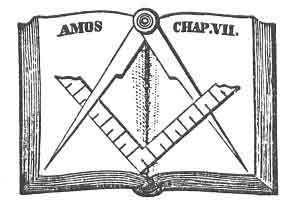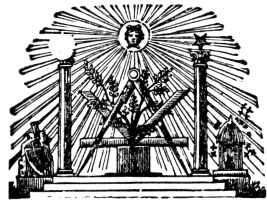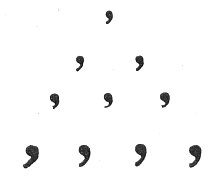“Have you ever worked as a Fellow Craft Mason?”
Ans. “I have in speculative; but our forefathers wrought both in speculative and operative Masonry.”
“Where did they work?”
Ans. “At the building of King Solomon’s temple, and many other Masonic edifices.”
“How long did they work?”
Ans. “Six days.”
“Did they not work on the seventh?”
Ans. “They did not.”
“Why so?”
Ans. “Because in six days God created the heavens and
p. 66
the earth, and rested on the seventh day; the seventh day, therefore, our ancient brethren consecrated as a day of rest from their labors; thereby enjoying more frequent opportunities to contemplate the glorious works of creation, and adore their great Creator.”
“Did you ever return to the sanctum sanctorum, or holy of holies, of King Solomon’s temple?”
Ans. “I did.”
“By what way?”
Ans. “Through a long porch or alley.”
“Did anything particular strike your attention on your return?”
Ans. “There did, viz.: two large columns, or pillars, one on the left hand and the other on the right.”
“What was the name of the one on your left hand?”
Ans. “Boaz, to denote strength.”
“What was the name of the one on your right hand?”
Ans. “Jachin, denoting establishment.”
“What do they collectively allude to?”
Ans. “A passage in Scripture wherein God has declared in his word, ‘In strength shall this house be established.'”
“What were their dimensions?”
Ans. “Eighteen cubits in height, twelve in circumference, and four in diameter.”
“Were they adorned with anything?”
Ans. “They were, with two large Chapiters, one on each.”
“Were they ornamented with anything?”
Ans. “They were, with wreaths of net-work, lily-work, and pomegranates.”
“What do they denote?”
Ans. “Unity, peace, and plenty.”
“Why so?”
Ans. “Net-work, from its connection, denotes union; lily-work, from its whiteness and purity, denotes peace; and pomegranates from the exuberance of its seed, denotes plenty.”
“Were those columns adorned with anything further?”
Ans. “They were, viz.: two large globes or balls, one of tack.
p. 67
“Did they contain anything?”
Ans. “They did, viz.. All the maps and charts of the celestial and terrestrial bodies.”
“Why are they said to be so extensive?”
Ans. “To denote the universality of Masonry, and that a Mason’s charity ought to be equally extensive.”
“What was their composition?”
Ans. “Molten or cast brass.”
“Who cast them?”
Ans. “Our Grand Master, Hiram Abiff.”
“Where were they cast?”
Ans. “On the banks of the river Jordan, in the clay ground between Succoth and Zaradatha, where King Solomon ordered these and all other holy vessels to be cast.”
“Were they cast sound or hollow?”
Ans. “Hollow.”
“What was their thickness?”
Ans. “Four inches or a hand-breadth.”
“Why were they cast hollow?”
Ans. “The better to withstand inundations and conflagrations; were the archives of Masonry and contained the constitution, rolls and records.”
“What did you next come to?”
Ans. “A long, winding stair-case, with three, five, seven steps or more.”
“What do the three steps allude to?”
Ans. “The three principal supports in Masonry, viz.: wisdom, strength and beauty.”
“What do the five steps allude to?”
Ans. “The five orders in architecture, and the five human senses.”
“What are the five orders in architecture?”
Ans. “The Tuscan, Doric, Ionic, Corinthian and Composite.”
“What are the five human senses?”
Ans. “Hearing, seeing, feeling, smelling and tasting, the first three of which have ever been deemed highly essential among Masons: hearing, to hear the word; seeing, to see the sign, and feeling, to feel the grip, whereby one Mason may know another in the dark as well as the light.
p. 68
“What do the seven steps allude to?”
Ans. “The seven sabbatical years, seven years of famine, seven years in building the Temple, seven golden candlesticks, seven wonders of the world, seven planets; but more especially the seven liberal arts and sciences, which are grammar, rhetoric, logic, arithmetic, geometry, music and astronomy. For these and many other reasons the number seven has ever been held in high estimation among Masons.”
“What did you next come to?”
Ans. “The outer door of the middle chamber of King Solomon’s Temple, which I found partly open, but closely tyled by the Junior Warden.”

Moe is the founder of GnosticWarrior.com. He is a father, husband, author, martial arts black belt, and an expert in Gnosticism, the occult, and esotericism.




